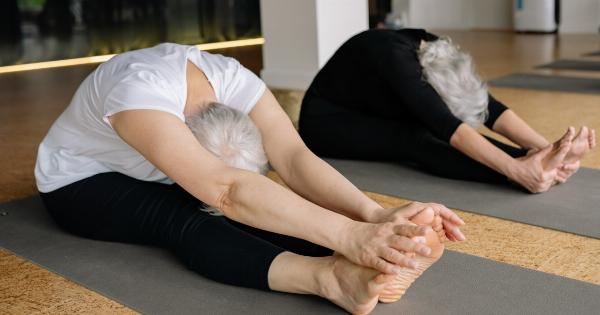Pregnancy is a beautiful and transformative time in a woman’s life. However, it can also come with certain discomforts and challenges. One common complaint among pregnant women is cramping.
While cramps during pregnancy are generally harmless, they can sometimes indicate a more serious underlying condition. In this article, we will explore the causes of pregnancy cramps and provide effective remedies to alleviate them.
What Causes Pregnancy Cramps?
Cramping during pregnancy can be caused by various factors. Here are some of the most common causes:.
1. Round Ligament Pain
Round ligament pain is one of the leading causes of cramping during pregnancy. As the uterus expands to accommodate the growing baby, the round ligaments that support the uterus stretch and thicken.
This stretching can cause sharp or dull cramping sensations on one or both sides of the lower abdomen.
2. Braxton Hicks Contractions
Braxton Hicks contractions, also known as “practice contractions,” are another common cause of cramping during pregnancy.
These contractions are the body’s way of preparing for labor and can be felt as intermittent, painless tightening or cramping in the abdomen.
3. Gas and Bloating
Pregnancy hormones can slow down digestion, leading to increased gas and bloating. This can cause discomfort and cramping in the abdominal area. Eating small, frequent meals and avoiding gas-inducing foods can help alleviate this issue.
4. Constipation
Hormonal changes during pregnancy can also affect bowel movements, leading to constipation. When stool builds up in the intestines, it can cause cramping and abdominal pain.
Staying hydrated, eating fiber-rich foods, and engaging in regular physical activity can help prevent and relieve constipation.
5. Urinary Tract Infections
Urinary tract infections (UTIs) are more common during pregnancy due to hormonal changes and increased pressure on the bladder. Along with frequent urination and a burning sensation, UTIs can also cause cramping in the lower abdomen.
If you suspect a UTI, it is important to seek medical attention for proper diagnosis and treatment.
6. Ectopic Pregnancy
An ectopic pregnancy occurs when a fertilized egg implants outside of the uterus, usually in the fallopian tube. This can cause severe cramping on one side of the abdomen, accompanied by vaginal bleeding.
Ectopic pregnancies are medical emergencies and require immediate medical attention.
7. Miscarriage
One of the most feared causes of cramping during pregnancy is miscarriage. Cramping accompanied by heavy bleeding and tissue passing from the vagina may indicate a miscarriage.
If you experience these symptoms, it is crucial to contact your healthcare provider immediately.
8. Preterm Labor
Preterm labor refers to labor that occurs before the 37th week of pregnancy. Cramping, lower back pain, and regular contractions that increase in intensity may indicate preterm labor.
Prompt medical attention is necessary to prevent premature birth and its associated risks.
Effective Remedies for Pregnancy Cramps
Now that we have explored the causes, let’s discuss some effective remedies to alleviate pregnancy cramps:.
1. Rest and Relaxation
When experiencing cramps, it is important to rest and relax. Lie down on your left side, which improves blood flow to the placenta and helps relieve cramping. Avoid strenuous activities and take breaks throughout the day.
2. Heat Therapy
Applying heat to the affected area can help relax the muscles and alleviate cramping. Use a warm compress, take a warm bath, or use a heating pad on a low setting. Be cautious not to apply excessive heat to avoid overheating.
3. Gentle Exercises
Engaging in gentle exercises can help relieve cramps and improve overall pregnancy discomfort. Opt for activities like walking, swimming, and prenatal yoga.
These exercises promote blood circulation, reduce muscle tension, and release endorphins, which are natural pain relievers.
4. Adequate Hydration
Ensure you drink plenty of water throughout the day. Dehydration can exacerbate cramping and lead to other pregnancy complications. Aim to drink at least eight glasses of water daily and increase your intake on hotter days or during physical activity.
5. Pelvic Tilts
Pelvic tilts can help relieve round ligament pain. Start by getting down on all fours and slowly tilting your pelvis forward and backward. This gentle movement stretches the ligaments and reduces cramping sensations.
6. Proper Posture
Maintaining good posture can help alleviate cramps and discomfort. Stand and sit up straight, keeping your shoulders back and relaxed. Avoid standing or sitting for prolonged periods, as it can lead to muscle tension and cramping.
7. Supportive Clothing
Wearing supportive clothing, such as maternity belts or belly bands, can help alleviate the strain on the round ligaments and reduce cramping. These garments provide gentle compression and support to the abdominal area.
8. Warm Water Soaks
Soaking in a warm bath can provide soothing relief from cramps. Add some Epsom salt to the water to further relax the muscles and reduce inflammation. Ensure the water is not too hot to avoid overheating and dehydration.
9. Massages
Gentle massages can help ease muscle tension and cramping. You can massage the affected area yourself or seek the assistance of a trained prenatal massage therapist. Use gentle strokes and apply light pressure to avoid any discomfort.
10. Proper Nutrition
Following a balanced diet rich in essential nutrients is crucial for overall pregnancy health, including preventing or reducing cramping. Incorporate foods high in calcium, magnesium, and potassium, such as leafy greens, bananas, and dairy products.
Conclusion
While pregnancy cramps can be uncomfortable and sometimes worrisome, they are usually a normal part of the pregnancy journey.
Understanding the potential causes of cramping and implementing effective remedies can help you alleviate discomfort and ensure a smoother pregnancy experience. Remember, if you ever have concerns about your cramps or any other pregnancy symptoms, it is essential to consult with your healthcare provider for proper evaluation and guidance.





























